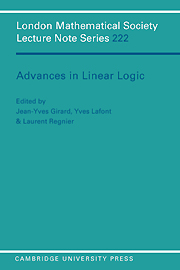Geometry of interaction III: accommodating the additives
Published online by Cambridge University Press: 17 February 2010
Summary
Abstract
The paper expounds geometry of interaction, for the first time in the full case, i.e. for all connectives of linear logic, including additives and constants. The interpretation is done within a C*-algebra which is induced by the rule of resolution of logic programming, and therefore the execution formula can be presented as a simple logic programming loop. Part of the data is public (shared channels) but part of it can be viewed as private dialect (defined up to isomorphism) that cannot be shared during interaction, thus illustrating the theme of communication without understanding. One can prove a nilpotency (i.e. termination) theorem for this semantics, and also its soundness w.r.t. a slight modification of familiar sequent calculus in the case of exponential-free conclusions.
Introduction
Towards a monist duality
Geometry of interaction is a new form of semantics. In order to understand what is achieved, one has to discuss the more traditional forms of semantics.
Classical model theory
The oldest view about logic is that of an external observer : there is a preexisting reality (mathematical, let us say) that we try to understand (e.g. by proving theorems). This form of dualism is backed by the so-called completeness theorem of Gödel (1930), which says that a formula is provable iff it is true in all models (i.e. in all realizations). There is strong heterogeneity in the duality world/observer (or model/proof) proposed by model-theory, since the latter is extremely finite whereas the former is infinite. Hilbert's attempt at reducing the gap between the two actors failed because of the renowned incompleteness theorems, also due to Godel (1931), whose basic meaning is that infinity cannot be eliminated.
- Type
- Chapter
- Information
- Advances in Linear Logic , pp. 329 - 389Publisher: Cambridge University PressPrint publication year: 1995
- 32
- Cited by

